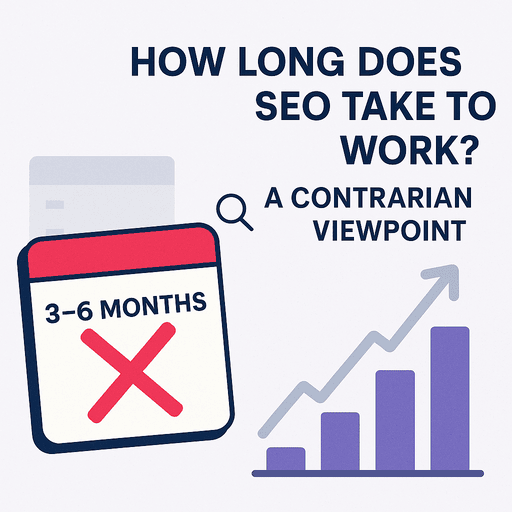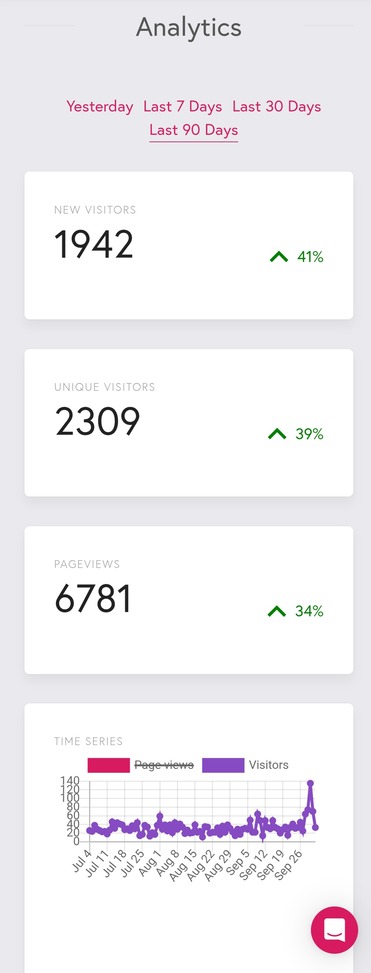How Long Does SEO Take to Work? A Contrarian Viewpoint

Short Answer: Most marketers say SEO takes 3–6 months, but that’s not always true. With the right actions, results can appear much faster. I saw measurable SEO traction in just one week after finally optimizing my decade-old portfolio site.
Introduction
“SEO takes time.” If you’ve researched SEO or spoken with an agency, you’ve probably heard the same refrain: expect results in three to six months. It’s repeated so often that it feels like a rule set in stone.
But here’s the problem: SEO doesn’t follow a stopwatch. Search results depend on dozens of factors that vary from one site to another. Sometimes SEO really does take months or even years to reach its full potential. But in other cases, results can show up much sooner than expected.
I learned this firsthand when I started practicing SEO on my personal portfolio site. Even though the site had been online for nearly a decade, I had never optimized it for search engines. Within a week of making some key changes, I saw measurable traffic growth, rankings in the top three positions on Google, and citations inside Google’s new AI Overviews. This case study shows why the traditional SEO timeline deserves a contrarian look.
Why the Standard SEO Timeline is Misleading
The “3–6 months” answer gets repeated in the industry because it’s safe. It sets a realistic expectation for clients in competitive industries and protects agencies from being blamed if rankings don’t shoot up overnight.
The problem is that this number oversimplifies SEO. Not every website starts from the same place. A new e-commerce brand competing against Amazon isn’t on the same playing field as a local bakery with no nearby digital competition. Treating SEO as if it always unfolds the same way does businesses a disservice.
Instead of asking how long SEO takes, the better question is what conditions make SEO faster or slower.
What Really Determines SEO Timelines
Competition plays a huge role. A local business in a smaller market often ranks much faster than a site competing nationally in a crowded industry.
Domain age and history matter too. An older site that’s been online for years often carries built-in trust, even if it’s never been optimized before. On the other hand, a brand-new domain may take longer to gain authority.
Content quality is another key driver. Search engines don’t just want keywords anymore; they prioritize fact-rich, entity-based content that fully answers a query. If your content delivers more depth and accuracy than competitors, results can come quicker.
Technical SEO can’t be ignored. Submitting a sitemap, improving site speed, fixing crawl issues, and ensuring mobile usability can make or break how quickly search engines index and reward your site.
Authority signals such as backlinks, brand mentions, and reviews build credibility over time. And in 2025, search evolution itself is a factor. Google’s AI Overviews, Bing Copilot, and DuckDuckGo’s ranking style are creating new ways for fresh content to be surfaced faster.
My Case Study: SEO Results in Just One Week
Background
I’ve had my portfolio website live for almost a decade, but it was basically a digital brochure. I posted writing samples to showcase my work but never invested in SEO. No keyword strategy, no optimization, no structured content. For years, it sat quietly in the background.
That changed on September 25, 2025 when I decided to treat my own site the same way I treat my clients — with an SEO-first strategy.
What I Did
First, I rewrote parts of my website copy. I optimized my About page with targeted keywords and updated my portfolio pages with copy that reflected both user intent and search engine signals. I created and submitted a sitemap to Google Search Console and Bing Webmaster Tools, which gave my site a direct line into both search engines.
Next, I started publishing my own blog posts on SEO strategy — the same types of thought-leadership articles I write for clients. To reinforce local signals, I also claimed my Google Business Profile and Bing Places equivalent.
Finally, I shared my blogs on LinkedIn and Twitter/X to extend reach, knowing that distribution beyond my site could drive traffic, build signals, and help those posts get discovered and indexed faster.
The Results
The impact was almost immediate. Within days, several of my blogs were cited by Google’s AI Overviews, giving me visibility in one of the most prominent areas of search results. A few posts also landed in the top three blue link rankings for their target keywords.
One of the strongest examples is my blog titled “Ultimate Guide on Offline Search Optimization.” If you Google the phrase offline search optimization today, you’ll find this article both cited directly by Google’s AI Overview and appearing in the top blue link results of the SERP. I even tested this in incognito mode to make sure my results weren’t skewed by personalization or search history.
I also noticed some of my LinkedIn-published articles started ranking in the top results on DuckDuckGo, which has a different algorithm than Google but still recognizes authority and relevance.
And the analytics confirmed what I was seeing in search:
-
New Visitors: 1,942 (+41%)
-
Unique Visitors: 2,309 (+39%)
-
Pageviews: 6,781 (+34%)
On average, each visitor viewed nearly three pages per session, showing they weren’t just landing and leaving — they were exploring multiple parts of my site.

Takeaway
This experience proved something important: SEO doesn’t always take months to work. Even a site that had been ignored for nearly 10 years can see results quickly once it’s optimized properly and paired with smart distribution. The standard timeline simply didn’t apply here.
Why SEO Can Sometimes Work Faster
My case study isn’t a fluke. SEO can move quickly under certain conditions. If you’re in a low-competition niche and publish high-value content, you can rank within weeks. An established domain that finally gets optimized often benefits from years of trust built into its history.
Fast technical adoption also accelerates timelines. Submitting sitemaps, cleaning up site architecture, and publishing mobile-friendly content give search engines immediate reasons to reward your site.
Leveraging multiple ecosystems matters. Today’s SEO isn’t just about Google — Bing, DuckDuckGo, and even social platforms like LinkedIn and Twitter/X feed into overall visibility. When you cover more bases, you see results faster.
Why SEO Can Take Longer
Of course, not every website will see results in a week. SEO still takes time when competition is steep. If you’re competing in niches like finance, insurance, or automotive, you’ll be up against brands with decades of authority.
If your site has technical flaws like crawl errors, broken links, or slow load times, those will hold you back. Similarly, if you target only high-volume, high-competition keywords, progress will be slow compared to focusing on long-tail or location-based queries.
And perhaps the biggest mistake: stopping too early. Many businesses give up on SEO after two or three months because they don’t see instant payoff. In reality, those first months often lay the foundation for the real growth that happens later.
FAQs
Can SEO work in less than 3 months?
Yes. My own results prove that with the right setup, you can see traction in weeks or even days.
Why do agencies all say 3–6 months?
Because it’s a safe generalization. It covers most scenarios but ignores the outliers where SEO can move faster.
Does having an old site help SEO?
Absolutely. Even if it wasn’t optimized before, domain age carries a trust signal that search engines consider valuable.
Does local SEO take less time than national SEO?
Often yes, since local niches are usually less competitive. But execution still matters more than the calendar.
Is SEO ever finished?
No. SEO is an ongoing process. Without continuous updates, rankings and visibility fade over time.
Conclusion: SEO is Situational, Not Calendar-Based
The idea that SEO takes three to six months is widespread, but it’s not the whole story. SEO is situational, not fixed. It depends on competition, domain authority, content quality, and technical health, not a stopwatch.
My own case study shows that with the right strategy, results can happen in days, not months. That’s the contrarian viewpoint: SEO isn’t about waiting out a timeline. It’s about executing with precision, amplifying your content, and staying consistent.
If you’re tired of cookie-cutter SEO timelines, contact me for a strategy built around your unique business conditions, one that works faster, smarter, and more sustainably.

0 Comments Add a Comment?